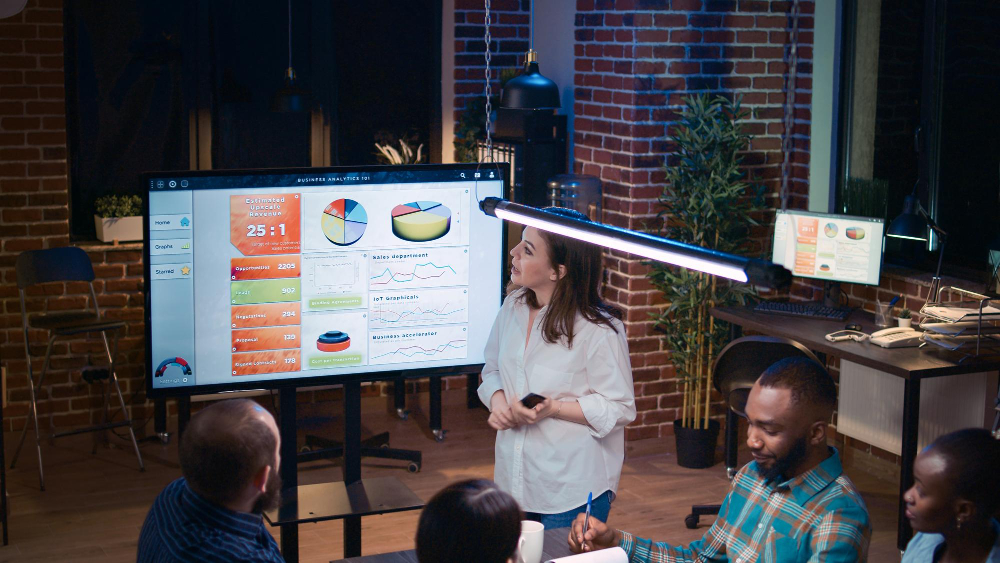Blog

Lobby Kiosk: Creating A Self-Service Solution In The Food Industry
The food industry has also shifted from offering client support to self-service. Touchscreen terminals can handle more challenging jobs as they become more user-friendly. Establishments are trading reception areas with interactive monitors.
The lobby kiosk is a versatile terminal for clubs, fast-food businesses, restaurants, and cafes. The pattern of using kiosks is present in most food establishments. The newest self-service platform now simplifies and upgrades the interaction between customers and staff.
What Is A Lobby Kiosk?
Kiosks are prevalent and assist in providing for customers in various sectors. There is no denying that they have improved a lot of firms. Kiosks are digital information centers with either non-interactive or interactive screens. Users can access a particular range of automated services at kiosks with touchscreens.
The design enables automated customer interaction with businesses, goods, brands, and services without additional staff. While kiosks are increasingly prevalent in various settings, quick-service restaurants are among their most well-liked uses.
What Does A Digital Self-Service Kiosk Do?
A digital self-service kiosk’s primary purpose is to enable users to independently carry out numerous routine functions. The digital device can perform customer service without the aid of personnel. A desk booking kiosk includes table reservations, food orders, and bill payments.
Whatever the kiosk’s purpose, the goal is to grant users more autonomy and improve productivity. Companies may automate straightforward procedures with self-service kiosks, which eliminates the need for additional staff.
Defining A Restaurant Kiosk
Small booths called kiosks are standard in fast-casual or quick-service restaurants. It can either transmit information or support a transaction.
Integrated with a point-of-sale system are self-order kiosks. On a little screen, customers can browse the menu, pick an item, and pay using cash or a credit card. Owners frequently locate food kiosks in busy areas to draw in more customers. The workload becomes streamlined for kitchen staff, and there is a significant reduction in waiting time.
Many diners use kiosks to enhance or replace conventional, in-person ordering. Kiosks are an efficient way to run a restaurant because they require less space and staff. They are an excellent means of promoting a brand and disseminating information about the business. Restaurants employ self-serve kiosks to display a computerized menu and enhance customer service.
Customers will discover something they love at kiosks because they have a wide selection of food alternatives. Restaurant operators might consider installing an ordering and booking kiosk to boost sales and attract more guests.
Five Advantages That Come With A Restaurant Kiosk
The majority of people have occasionally used a kiosk. Hardware for kiosks is available everywhere, including in stores, airports, and banks. Restaurant ordering kiosks have been increasingly prevalent over the past few years. Some restaurants have stopped using their host stand and have used the service kiosks.
A restaurant kiosk offers a variety of advantages. It provides a multitude of options and is quick and straightforward to use. Here are the top 5 benefits of using kiosks:
#1 Accurate Orders
In a high-paced restaurant serving fast food, order accuracy is crucial. One mistake will cause a queue to stay caught up. Hungry customers are generally upset by this, especially when a business advertises itself as fast food.
When there are more people and fewer computers, human error always arises. Computers don’t experience fatigued or become sidetracked. They show a digital menu, take customer data, process it, and complete transactions.
The kitchen crew has access to a display system that shows all orders entered. The display helps them know which orders come first. Accuracy enhances the patron experience in a traditional dining room and a food truck restaurant. Additionally, it improves a restaurant’s brand while streamlining the cooking processes.
#2 Labor Charges
Restaurant profit margins have historically been modest. Being a successful restaurant entrepreneur is difficult due to high overhead costs and a cutthroat industry. A lobby kiosk is an advantage for a quick-service restaurant against its competitors.
Owners must drastically reduce labor expenses and overhaul many of their operations to stay viable. A kiosk system can assist in accomplishing that. Why many restaurant owners want to use a cloud-based kiosk system to cut labor costs is understandable.
Customers may do much of the work, so self-ordering kiosks require less manpower. They can order food and obtain information without needing to ask a staff. There are fewer mistakes made when orders are input into a computer system. As a result, there are fewer redos and less food waste. An optimized ordering system is essential when restaurants must stay as close to their budget.
#3 Faster Ordering Time
Everyone is aware that patrons of quick-service restaurants detest standing in line. Reducing lengthy wait times is one of the management of restaurants’ most challenging issues. Hungry customers tend to be impatient. Disaster will follow when there are too few personnel and many angry clients.
A restaurant kiosk with a POS platform facilitates a noticeably quicker ordering process. Customers can automatically enter their orders and then wait at the counter. It helps to complete orders faster and more efficiently. Each order placed at a kiosk is done so in the order seen on a kitchen display. Faster ordering time guarantees customers receive their products on time, avoiding conflicts or delays.
#4 Guarantee Customer Satisfaction
Making customers happy is the fundamental objective of the restaurant industry to keep them away from competitors. Quick service, knowledgeable staff, and unique and top-notch food guarantee customer satisfaction. However, restaurants need to go above and above in this day and age.
One of those unique aspects that can elevate a company is the easy lobby kiosk. They are engaging, fun, customer-facing, and packed with helpful information. Restaurants have complete discretion over how and where to utilize them. Establishments can boost sales by including captivating displays about their business background and menu.
All of this enhances a restaurant’s customer satisfaction and outreach. Restaurant kiosks lower wait times and increase order accuracy, processes are more straightforward, and customers are happier.
#5 Personalized Add-Ons
Customizing and personalizing restaurant information is one of the best aspects of order kiosks. Owners can structure their kiosks to promote their most profitable and well-liked products. They can include images, often raising demand for specific products and boosting orders.
Businesses can also give clients detailed information about every menu item, so they know what they are getting. Customers will be pleased, and profit margins will increase.
Depending on the vendor a kiosk owner selects, the kiosk’s functionality might vary. Owners may easily alter the material, add new features, and remove out-of-date information—most software modifications for booths off-site allow for quick and seamless updates. Personalization enhances a restaurant’s reputation, guarantees order correctness, and gives devoted customers real-time menu board information.
How Does A Kiosk Work?
An interactive device called a self-service kiosk enables users or customers to execute their transactions. Self-service kiosks are in restaurants and retail stores for ordering food and paying for it.
A lobby kiosk can offer the following:
- Web browsing
- View multimedia files
- Access to software programs
- Browse maps
- And many more
Hardware for kiosks consists of everything save the software. It may also be necessary to have peripherals like thermal printers, card readers, speakers, etc., to enable some functionalities.
#1. Touchscreen
Without a touch screen, a kiosk is inoperable. Touch screens are more user-friendly than non-touch ones because they imitate the smart-style interface. These interactive panels help clients place orders and buy things by directing them through menus.
#2. Speakers
A typical set of built-in speakers provide the desk booking kiosk with sound. Speakers are an excellent option to offer a sound guide for visually impaired people.
#3. Barcode Reader
Data collection is more effective, accurate, and secure with scanners. Kiosks need a scanner to read 1D and 2D codes on paper or mobile devices. Tickets, loyalty cards, IDs, and receipts are among the things that barcode readers can scan.
#4. Card Reader
Card readers are necessary for any business because credit cards are still the most often used form of payment. Self-service kiosks are becoming more common in restaurants and retail establishments. Booths with card readers can process transactions and keep track of sales for business owners.
#5. Printer For Receipts
Depending on how the kiosk works, restaurants might require a receipt printer. If necessary, the function determines the type.
#6. Coin Or Bill Receiver
Including a bill receiver in the kiosk is crucial since some consumers still use physical currency to make financial transactions. Not all customers want to do cashless or card transactions. It’s also an advantage, especially if there is a problem with internet connection.
Bottom Line
A booking kiosk is becoming more common in several businesses where providing excellent customer service is crucial. A kiosk is an affordable alternative that aids business owners in enhancing client satisfaction and boosting sales.
Self-service applications offer potential sources of competitive advantage that are too important to ignore. The potential for transformation of services, customer service expansion, and new services are examples of rapidly changing technology. Kiosks are not here to replace manpower but to assist workers in providing excellent customer service.



















































 Support
Support  Demo
Demo  Blog
Blog 


